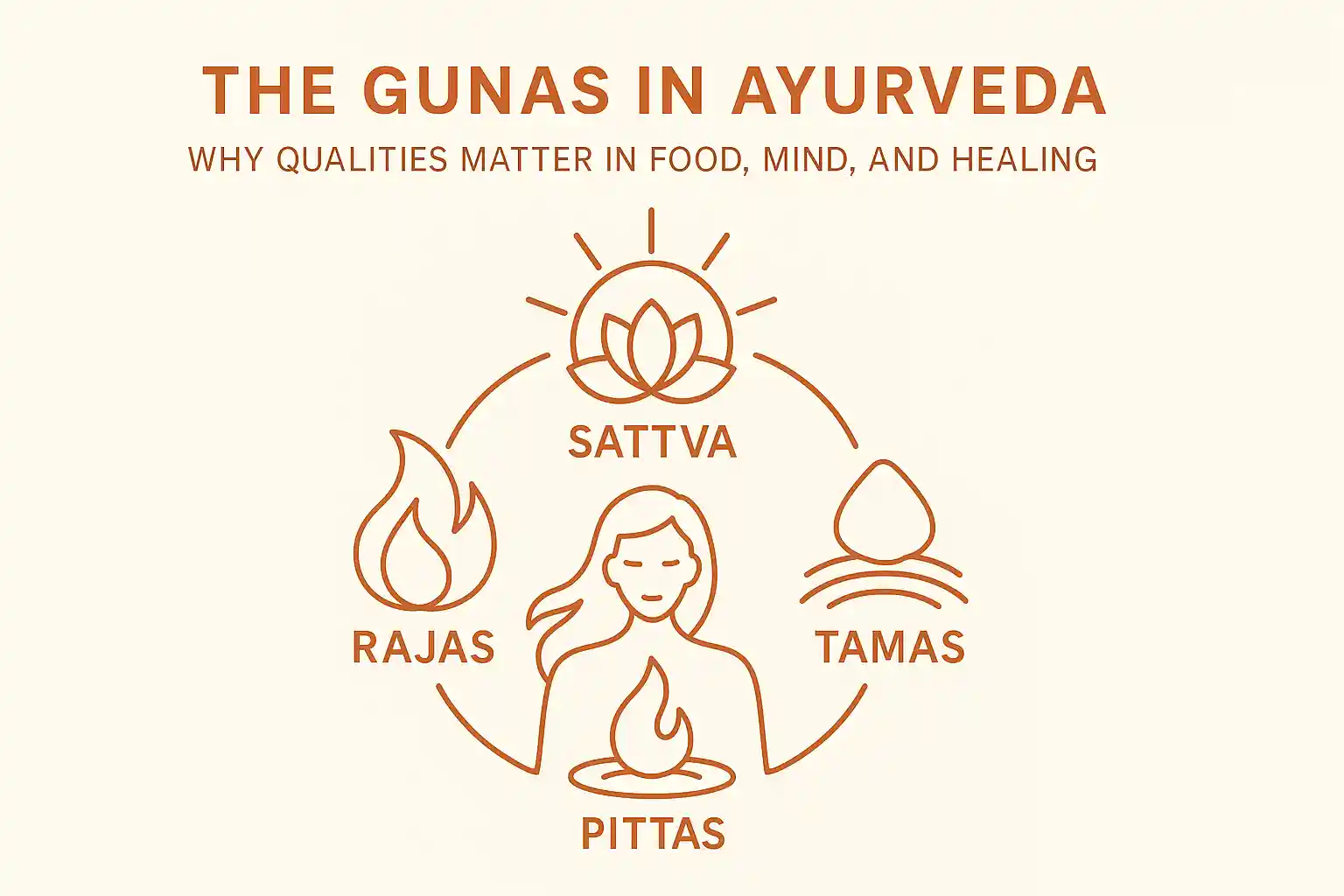In Ayurveda, everything in the universe is understood in terms of qualities, or Gunas. These subtle attributes shape how food, thoughts, seasons, and even relationships affect our body and mind. Understanding Gunas is essential to making wise choices that align with your Dosha and current state of balance.
The Gunas are the language of qualities—they help us perceive the energetic effect something will have. Is it heating or cooling? Heavy or light? Moist or dry?
Ayurveda classifies twenty key Gunas, organized into ten pairs of opposites. The concept is described in foundational texts such as the Charaka Samhita (Sutrasthana 1.49) and Ashtanga Hridayam, emphasizing that these qualities govern both physiological and psychological processes.
The 10 Pairs of Opposing Gunas
| Guna Pair | Examples | Effects on the Body |
|---|---|---|
| Heavy (Guru) vs Light (Laghu) | Dairy, meats vs. leafy greens, legumes | Heavy slows digestion, Light increases mobility |
| Oily (Snigdha) vs Dry (Ruksha) | Ghee, avocados vs. crackers, popcorn | Oily soothes Vata, Dry aggravates it |
| Cold (Shita) vs Hot (Ushna) | Coconut, cucumber vs. chili, garlic | Cold calms Pitta, Hot calms Kapha |
| Dull (Manda) vs Sharp (Tikshna) | Cooked food vs. raw onions, spices | Sharp stimulates Agni, Dull can soothe excess Pitta |
| Smooth (Shlakshna) vs Rough (Khara) | Bananas, cooked grains vs. raw veggies | Smooth calms Vata, Rough increases elimination |
| Dense (Sandra) vs Liquid (Drava) | Cheese vs. soups, teas | Liquid increases flow, Dense increases heaviness |
| Soft (Mridu) vs Hard (Kathina) | Ripe fruits vs. nuts, raw root veggies | Soft soothes, Hard stimulates structural tissues |
| Stable (Sthira) vs Mobile (Chala) | Root vegetables vs. coffee, travel | Stable grounds Vata, Mobile increases mental activity |
| Subtle (Sukshma) vs Gross (Sthula) | Essential oils vs. dense food | Subtle affects the mind, Gross affects the body |
| Clear (Vishada) vs Cloudy (Picchila) | Herbal tea vs. creamy sauces | Clear aids clarity, Cloudy can lead to sluggishness |
How Gunas Influence Dosha
Each Dosha is a combination of specific Gunas derived from the five elements:
Vata
Dry, light, cold, mobile, rough, subtle
Pitta
Hot, sharp, oily, light, spreading
Kapha
Heavy, cold, soft, oily, dense, stable
When you consume food or engage in activities that match your Dosha's Gunas, you may tip into imbalance. When you choose opposite Gunas, you promote balance.
Example: A Vata type (light, dry) benefits from oily, grounding foods. A Pitta type (hot, sharp) benefits from cool, dull foods. A Kapha type (heavy, oily) thrives with light, dry, warming meals.
What If You're Dual-Doshic? Gunas and Eating for Two Doshas
If you have a dual-Doshic constitution (like Vata-Pitta or Kapha-Pitta), your food choices must consider the Gunas of both Doshas. This can seem complex—but using the Gunas helps simplify it.
Here's how to work with Gunas as a dual-Doshic type:
Strategies for Dual-Doshic Types
- Notice the imbalance first: Treat the aggravated Dosha. If you're Vata-Pitta and feeling dry, anxious, and constipated, prioritize grounding (heavy, oily, stable) Gunas for Vata.
- Avoid extremes: Choose meals with moderate Gunas when both Doshas are sensitive. For example, lightly spiced, cooked grains with ghee and steamed vegetables suit both Vata and Pitta.
- Watch seasonal shifts: In summer, reduce heat (Pitta); in fall, counter dryness and lightness (Vata). Gunas help fine-tune your seasonal eating.
- Create balanced plates: Mix Gunas on your plate—like warm, oily basmati rice with a bitter green chutney. This satisfies multiple needs.
Understanding Gunas gives dual-Doshic people flexibility without confusion. Instead of rigid food lists, think in qualities. This approach works especially well with proper food combining principles that consider how different Gunas interact.
Gunas in Daily Life: Beyond Food
Gunas aren't just in food—they show up in everything:
Sleep
Deep, uninterrupted sleep is heavy and stable; restless sleep is light and mobile
Exercise
Intense cardio is hot, sharp, mobile; yoga nidra is dull, soft, subtle
Music
Loud, fast music is sharp and mobile; classical ragas may be smooth and stable
Weather
Dry wind is rough and mobile; humid summer is hot and oily
Tuning into the Gunas around you helps you make daily micro-adjustments. If your mind feels scattered (mobile, light), engage in heavy, stable activities like walking in nature or self-oil massage. This awareness becomes especially important with seasonal changes that naturally shift environmental Gunas.
Gunas in Food Selection
Understanding Gunas allows you to:
- Choose meals that balance your Dosha
- Adapt diet for seasons, stress, or illness
- Recognize why some "healthy" foods may not suit you
Examples:
- Light + dry = great for Kapha, aggravating for Vata
- Hot + oily = pacifies Vata, aggravates Pitta
- Cold + dense = soothes Pitta, worsens Kapha
Always ask: What is the quality of this food? What effect will it have on me right now? This becomes particularly important when understanding how the six tastes carry specific Guna combinations that affect your constitution.
Gunas and the Mind
Gunas also influence mental states. For instance:
- Mobile + subtle qualities support creativity but may cause anxiety
- Stable + heavy bring calm but may lead to dullness
- Sharp + light support clarity and focus
Understanding these can guide lifestyle, media consumption, relationships, and emotional health.
Final Thoughts
The Gunas are a foundational lens in Ayurveda. They empower you to go beyond rigid diets and tune into what your body-mind actually needs in each moment. By becoming fluent in the language of qualities, you gain the power to balance yourself naturally—with food, breath, movement, and intention.
Ready to apply Guna wisdom to your daily life?
Frequently Asked Questions
Common questions about understanding and applying Gunas in daily life

